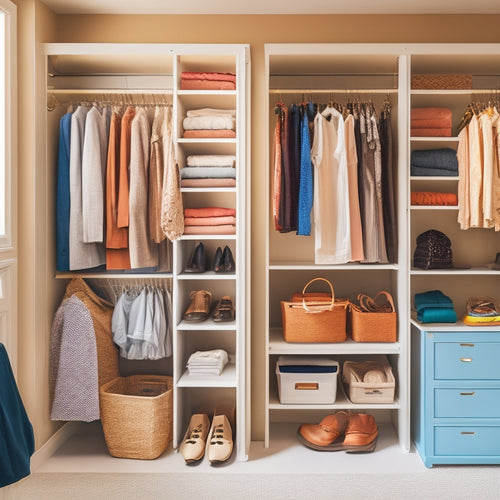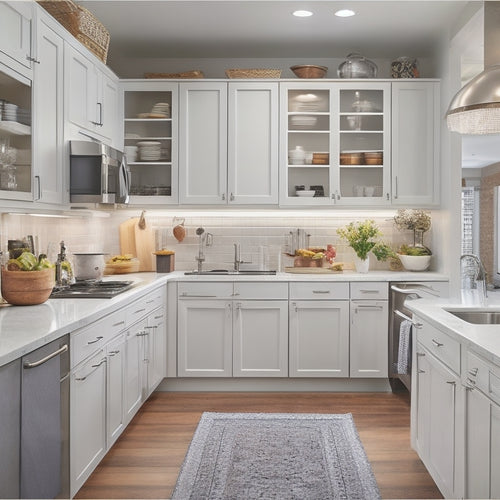
Custom Garage Shelving Units: A Step-by-Step Guide
Share
You're about to change your cluttered garage into a highly organized space with custom shelving units customized to your specific needs. Start by evaluating your garage space, measuring the width, length, and height of the area, and identifying obstacles like plumbing and electrical outlets. Next, choose the right materials, considering wood and metal options, and plan your shelving layout based on the items you need to store. From there, build your shelving frames, add shelves and accessories, and install the units strategically, ensuring proper installation and a clutter-free space. Now, get ready to optimize your garage organization with these expert steps ahead.
Key Takeaways
- Assess garage space by measuring dimensions, identifying obstacles, and categorizing items to be stored for optimal shelving design.
- Choose materials (wood or metal) based on budget, desired appearance, and weight capacity, considering pros and cons of each option.
- Design shelving units by taking inventory of items, measuring garage dimensions, and planning layout around obstructions and electrical outlets.
- Build shelving frames with durable materials, ensuring sturdiness, levelness, and stability, and incorporate features like adjustable heights and leveling feet.
- Install shelving units strategically, securing them to walls or floors, and regularly assess and adjust organization to maintain a clutter-free space.
Assessing Your Garage Space
Frequently, homeowners plunge headfirst into custom garage shelving projects without taking the time to assess their garage space. You don't want to make the same mistake.
Take a step back, and carefully examine your garage's layout, dimensions, and contents. Measure the width, length, and height of the area where you plan to install the shelving unit. Identify any obstacles, such as plumbing, electrical outlets, or windows, that may impact your design.
Consider the types of items you'll be storing and how you want to group them. Effective space optimization and garage organization require a thorough understanding of your garage's unique characteristics.
Don't forget to declutter your garage space by adopting a one in, one out policy and sorting items into categories, which will help you create a more organized and functional space.
Choosing the Right Materials
You've assessed your garage space, and now it's time to decide on the materials for your custom shelving unit. You have two primary options: wood and metal.
Wood options, such as pine, cedar, or reclaimed wood, offer a warm, natural aesthetic and can be stained or painted to match your garage's style. However, wood may be prone to warping or rotting if exposed to moisture.
Metal, on the other hand, provides exceptional durability and can withstand heavy loads. Consider powder-coated or galvanized metal for added corrosion resistance.
When choosing between wood and metal, consider your budget, desired look, and the weight capacity you need. Research and weigh the pros and cons to select the material that best suits your custom garage shelving unit.
Measuring and Designing Units
You'll need to take stock of the items you want to store and measure your garage's dimensions to determine the maximum size of your shelving unit.
Next, plan the shelving layout to guarantee it fits your needs and makes the most of the available space.
Take Inventory Space
Your garage's unique dimensions and storage needs dictate the custom shelving units you'll design. To create effective storage solutions, take inventory of the items you need to store and prioritize them. Consider the frequency of use, size, and weight of each item. This will help you determine the type and number of shelves, bins, and hooks you'll need.
| Item Category | Quantity | Storage Requirements |
|---|---|---|
| Seasonal Decor | 5 | Shelves with 12" clearance |
| Tools | 10 | Hooks and small bins |
| Sports Equipment | 3 | Large bins and shelves with 24" clearance |
Measure Garage Dimensions
Now that you've got a clear image of the items you need to store, it's time to assess the space where they'll be stored.
Measuring your garage dimensions is essential for effective garage organization and space optimization.
- Record the length, width, and height of your garage in inches.
- Measure the distance from the floor to any obstructions like pipes, ductwork, or windows.
- Note the location of any electrical outlets, switches, or other features that might affect shelving placement.
With these measurements, you'll be able to design a custom shelving unit that fits your garage perfectly, maximizing storage space and minimizing clutter.
Plan Shelving Layout
With garage dimensions in hand, designing a custom shelving unit that efficiently employs every available inch becomes a more manageable task.
Now, it's time to plan your shelving layout. Determine the ideal shelving height based on the items you'll be storing. Consider the load capacity you need for each shelf, ensuring it can hold the weight of your storage bins, tools, or equipment.
Visualize the layout, taking into consideration any obstructions like windows, doors, or electrical outlets. Sketch a rough design, including the number of shelves, their dimensions, and the material you'll use.
This will help you optimize your space and create a functional shelving system that meets your specific needs.
Building the Shelving Frames
You'll start building your custom garage shelving units by designing the shelving frames, factoring in the load capacity and size you determined during the measuring and designing phase.
Next, you'll select the frame material, considering factors like durability, weight, and corrosion resistance.
With your design and materials in hand, you can begin assembling the frames, ensuring they're sturdy and level to support your shelving units.
Shelving Frame Design
Designing the shelving frame is an essential step in building custom garage shelving units, as it provides the structural backbone for your storage system.
You'll want to take into account several factors to guarantee your shelves meet your specific needs.
-
You can choose from various frame styles to match your design aesthetics, such as modern, industrial, or traditional.
-
Reflect on the weight capacity you need, as well as modular options that allow you to add or remove shelves as needed.
-
Think about stability features, like adjustable heights and leveling feet, to make certain your shelves remain secure and level.
Frame Material Selection
Having settled on a shelving frame design that meets your needs, it's time to select the materials that will bring your custom garage shelving unit to life.
You're faced with an essential decision: wood vs metal. Both options have their pros and cons.
Wood frames offer a traditional look and can be stained to match your garage's aesthetic. However, they're more prone to warping and rotting, especially in humid environments.
Metal frames, on the other hand, are durable and can support heavier loads, but they can be noisy and may rust if not properly coated.
Durability considerations are key when choosing your frame material.
Consider the weight capacity you need, the climate you're in, and your personal preferences to make an informed decision.
Assembling the Frames
With your frame material selected, it's time to bring your custom garage shelving unit to life by assembling the frames.
Start by following the manufacturer's instructions for assembling the vertical frames, ensuring they're level and secure. Next, attach the horizontal beams, making sure they're evenly spaced to provide ideal shelf stability.
- Use corner brackets to reinforce the frame's joints, adding strength and frame aesthetics.
- Double-check the frame's levelness and plumbness to prevent any future issues.
- Consider adding a back panel to the frame for added stability and to keep items from falling off the back of the shelf.
Adding Shelves and Accessories
You're now ready to add shelves and accessories to your custom garage shelving unit, converting it into a highly functional and organized space.
Start by attaching the shelves to the frame, ensuring they're level and secure. Consider your shelf organization needs: do you need fixed shelves for heavy items or adjustable shelves for flexibility?
Next, investigate accessory options to maximize storage and efficiency. Add bins, baskets, or hooks to store items like tools, sports equipment, or cleaning supplies.
You can also install a slatwall or pegboard for hanging items like bikes, gloves, or accessories. Think about your specific needs and preferences to create a customized space that meets your requirements.
Installing the Shelving Units
Install your custom garage shelving units in a strategic location, guaranteeing easy access to frequently used items while keeping the floor clear for vehicles or other activities. This will help you maximize your garage's storage potential and maintain a clutter-free space.
-
Confirm shelf stability by securely fastening the units to the wall or floor to prevent tipping or collapse.
-
Check the weight capacity of each shelf to avoid overloading and potential damage.
-
Use adjustable shelves to accommodate items of varying sizes and weights, allowing for flexible storage and easy reconfiguration.
Final Touches and Tips
As you step back to admire your newly installed custom garage shelving units, take a moment to fine-tune the space by adding a few finishing touches.
Label each shelf or bin to guarantee you can easily find what you need. Consider adding a pegboard for hanging tools and accessories, keeping them within easy reach.
Implement organization tips like storing heavy items at the bottom and lighter ones at the top to maintain stability.
Don't forget to leave some extra space for future additions or seasonal items.
Frequently Asked Questions
Can I Use Custom Garage Shelving Units for Commercial Purposes?
You can definitely use custom garage shelving units for commercial purposes, but make sure they're designed for heavy-duty commercial storage and have a weight capacity that meets your business needs, ensuring safe and efficient storage.
Are DIY Custom Garage Shelving Units Durable Enough?
You're wondering if DIY custom garage shelving units are durable enough? They can be, if you choose materials with high strength and design for sufficient load capacity, ensuring your shelves can hold the weight you need them to.
Can I Install Shelving Units on Uneven Garage Floors?
You'll be surprised to know that 75% of garages have uneven floors! To guarantee shelving stability, you can install flooring solutions like shims, self-leveling compounds, or adjustable feet to compensate for imperfections, allowing you to securely install shelving units.
How Often Should I Clean and Maintain Custom Shelving Units?
You'll want to clean your custom shelving units every 2-3 months, depending on usage, and perform deeper maintenance tasks like tightening screws and lubricating hinges every 6-12 months to keep them in top shape.
Are Custom Garage Shelving Units Suitable for Outdoor Use?
You'll want to evaluate weather resistance when deciding if custom shelving units are suitable for outdoor use; choose materials that can withstand the elements, like rust-resistant metal or durable plastics, to guarantee your units last.
Related Posts
-

Free Printable Closet Organization Checklists for Success
You're ready to tackle your closet clutter and create a peaceful space that sparks joy. A free printable closet organ...
-

Why Cluttered Spaces Hold You Back From Productivity
You're struggling to get things done amidst the chaos of your cluttered space. It's not just a physical mess - it's m...
-

Why Narrow Kitchens Need Space-Saving Solutions
In your narrow kitchen, every inch is precious real estate. You know how quickly clutter can take over, making meal p...


